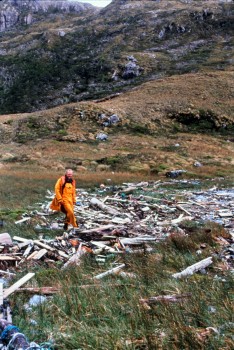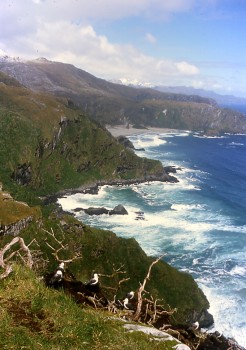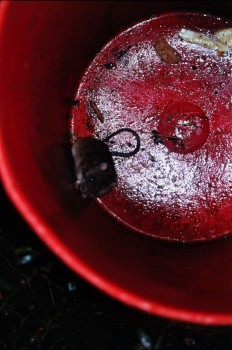In Chile’s western Patagonia huge numbers of fjords and archipelagos make up one of the least populated and explored areas in the World. Among this complex system lie islands such as Isla Diego de Almagro that are exposed to the severe weather conditions of the Cape Horn current and western drift winds. The western coastline of the 525-ha island is composed of high cliffs and offshore islets. Isla Diego de Almagro has been a Chilean National Reserve ("Reserva Nacional Alacalufes") since 1969 and has been identified as an Important Bird Area (IBA) by BirdLife International.
The western coastline of Isla Diego de Almagro
Diego de Almagro was first reported as supporting breeding Near Threatened Black-browed Albatrosses Thalassarche melanophris in January 1984 with abundance estimates of around 15 000 breeding pairs made by the late Gerry Clark’s Totorore Expedition. This estimate was later confirmed by a count of 15 594 breeding pairs in six colonies scattered along offshore islets and the exposed western-facing cliffs from photographs taken from the yacht Tooluka in September 2001.
An estimated total of 122 920 pairs of Black-browed Albatrosses breed within Chile at six island localities. Following Islas Diego Ramírez and Ildefonso, Isla Diego de Almagro supports the third largest population in Chile.
The prevailing weather conditions in the region and rugged terrain on Diego de Almagro make it difficult both to undertake aerial photographic surveys and-based monitoring with walking trips of up to 8-10 hours being necessary to visit even the most accessible breeding colonies.

Breeding Black-browed Albatrosses on Diego de Almagro
Trackers deployed on 13 Black-browed Albatrosses on Diego de Almagro during incubation in 2001 confirmed the species’ occurrence along the Chilean continental shelf, overlapping with commercial fisheries in the region.

Roger Kirkwood (Australian Antarctic Division) stands amongst debris washed ashore on Diego de Almagro
Diego de Almagro's shoreline contains much washed-up debris from fisheries (e.g. nets, buoys), and plastic artefacts such as lighters, lubricant bottles and bags; the last widely distributed across the island by the dominant windy conditions. In contrast with more southerly colonies (Isla Diego Ramírez >700 km southward), Diego de Almagro shows signs of invasive rodent presence with House Mouse Mus musculus faeces observed around albatross nests. In addition, the introduction of alien predators such as domestic dogs and cats via landings made by artisanal fishers on Diego de Almagro remains an ongoing risk (click here).
A native rodent found on Diego de Almagro
Photographs by Marcelo A. Flores.
Selected References:
Clark, G.1988. The Totorore Voyage. Auckland: Century Hutchinson. 357 pp.
Clark, G.S., Goodwin, A.J. & von Meyer, A.P. 1984. Extension of the known range of some seabirds on the coast of southern Chile. Notornis 31: 320-334.
Clark, G.S., Cowan, A., Harrison, P. & Bourne, W.R.P. 1992. Notes on the seabirds of the Cape Horn islands. Notornis 39: 133-144.
Lawton, K., Robertson, G., Valencia, J., Wienecke, B. & Kirkwood, R. 2003. The status of Black-browed Albatrosses Thalassarche melanophrys at Diego de Almagro Island, Chile. Ibis 145: 502-505.
Moreno, C.A. & Robertson, G. 2008. ¿Cuántos albatros de ceja negra, Thalassarche melanophrys (Temminck, 1828) anidan en Chile? Anales Instituto Patagonia 36: 89-92.
Suazo, C.G., Schlatter, R.P., Arriagada, A.M., Cabezas, L.A. & Ojeda, J. 2013. Fishermen’s perceptions of interactions between seabirds and artisanal fisheries in the Chonos archipelago, Chilean Patagonia. Oryx 47: 184-189. + one page supplementary material on-line.
Tickell, W.L.N. 1976. The distribution of Black-browed and Grey-headed albatrosses. Emu 76: 64-68.
Cristián G. Suazo, Department of Animal Ecology and Systematics, Justus Liebig University, Giessen, Germany, Marcelo Flores, Departamento de Ecología y Biodiversidad, Universidad Andres Bello, Chile & Graham Robertson, Australian Antarctic Division, Chamnnel Highway, Kingston, Tasmania, 04 January 2014, updated 05 January 2014

 English
English  Français
Français  Español
Español 
